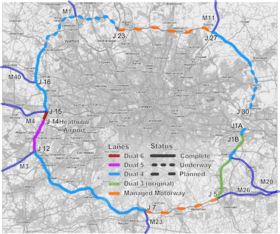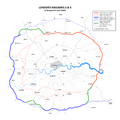M25 motorway facts for kids
Quick facts for kids
M25 motorway |
|
|---|---|
| Lua error in Module:Infobox_road/map at line 15: attempt to index field 'wikibase' (a nil value).
M25 highlighted in dark blue.
|
|
| Route information | |
| Part of |
|
| Length | 117 mi (188 km) |
| Existed | 1975–present |
| History | Completed 1975-1986 |
| Major junctions | |
| Orbital around London | |
| From | Hawley (near Dartford) (A2) |
J2 → M2 motorway
J12 → M3 motorway Junction 2 J15 → M4 motorway Junction 4b J16 → M40 motorway Junction 1a J21 → M1 motorway Junction 6a J23 → A1(M) motorway Junction 1 J27 → M11 motorway Junction 6 |
|
| To | West Thurrock (A13) |
| Location | |
| Primary destinations: |
London, Dartford, Sevenoaks, Reigate, Staines, Heathrow Airport |
| Road network | |
|
|
The M25 motorway, or London Orbital, is a 117-mile (188 km) orbital motorway around Greater London.
The motorway was first suggested early in the 20th century, and a few sections were built in the early 1970s. The M25 was completed in 1986: is one of the world's longest orbital roads.
It is one of the busiest and most congested parts of the British motorway network. 196,000 vehicles were recorded in a single day near London Heathrow Airport. The M25 is a cruclial link between the four main London airports: Heathrow, Gatwick, Stansted and Luton.
Bearing in mind that no motorways go through the centre of London, the M25 is a main route connecting north with south, and east with the west of England.
The motorway was originally built with only six lanes (three each way), despite research which suggested eight lanes were necessary. Now a fourth lane exists over most of the motorway, and more in special sections (see diagram). Plans were scaled back in 2009 in response to rising costs, but work is still going on.
Planning
Public enquiries continued through the 1970s and 1980s. Each section had its own enquiry, where local citizens and interest groups could question the plans. In all, "39 public inquiries before independent Inspectors were held, taking over 700 sitting days – with many more working days (and nights) preparing evidence". Objectors could put forward alternatives, and each of these had to be answered with presentation of evidence. Evidence included predictions of traffic and events which would affect growth of traffic. Enquiries and evidence were open to public scrutiny and debate.
Some enquiries lasted a day, and one one lasted 97 sitting days over 13 months. Proposals had to go before Parliament, and a special Act was needed to authorise the crossing of the northern tip of Epping Forest by the route in tunnel.
Operational history
As predicted by research, soon after the motorway opened in 1986 traffic levels exceeded maximum designed capacity. In 1990 the Secretary of State for Transport announced plans to widen the whole of the M25 to four lanes. By 1993 the motorway that was designed for a maximum of 88,000 vehicles per day was carrying 200,000. 15% of UK motorway traffic volume was on the M25 and there were plans to add 6 lanes to the section from Junction 12 to 15 as well widening the rest of the motorway to 4 lanes.
In 1995 a contract was awarded to widen the section between junctions 8 and 10 from six to eight lanes for a cost of £93.4 million and a 'Motorway Incident Detection and Automatic Signalling' (MIDAS) system was introduced to the M25 from junction 10 to junction 15 at a cost of £13.5m in 1995 and then extended to junction 16 at a cost of £11.7m in 2002. This consists of a distributed network of traffic and weather sensors, speed cameras and variable-speed signs that control traffic speeds with little human supervision. The system has improved traffic flow slightly, and reduced the amount of start-stop driving. The use of variable speed limits makes this a "controlled motorway", and if hard shoulders are used at peak times it becomes a "managed motorway".
In 1995 there was a proposal to widen the section close to Heathrow Airport to 14 lanes. This attracted fierce opposition from road protesters opposing the Newbury Bypass and other schemes, and it was cancelled shortly afterwards. However, in 1997 the Department of Transport announced new proposals to widen the section from junction 12 (M3) and junction 15 (M4) to 12 lanes. At the Terminal Five public inquiry a Highways Agency official said that the widening was needed to accommodate traffic to the proposed new terminal, however the transport minister said that no such evidence had been given. Environmental groups objected to the decision to go ahead without holding a public inquiry. A decision to go-ahead was given for a 10-lane scheme in 1998, and the £148 million 'M25 Jct 12 to 15 Widening' contract was awarded to Balfour Beatty in 2003. The scheme was completed in 2005 as dual-five lane between junctions 12 to 14 and dual six lanes from 14 to 15.
Costs
The road cost £1 billion (in 1980s money) and took 11 years to build. It used two million tons of concrete and 3½ million tons of asphalt.
Dartford
Traffic bottleneck at the Dartford Crossing in the east is the greatest problem on the motorway at present, even though the crossing is technically not part of the M25. At present the crossing is by bridge from the north, and by tunnel from the south. There are usually long tailbacks in both directions.
Consequences
On its 25th birthday the BBC listed some of its effect on life near the capital:
- Built business empires and spread business from the capital. A new commercial property market has developed. In the M25 area there is 130 million square feet of extra commercial space. Compare this with the City of London, where the total is about 170 million square feet. The M25 is a big catchment area in terms of employment.
- Increased house prices. Before the M25, areas just outside London were a mixture of small rural farms and commuter belt. Its arrival helped those commuters get on their way faster, pushing house prices in such areas higher. "We know from our research that house prices generally have gone up about 300% since the M25 opened in 1986," says Anthony Wardell from Knight Franks estate agents. On the western side of London, house prices have gone up nearer to 400%, he adds.
- Changed the way people plan their lives. M25 expert Chris Marshall says "You can get around London in ways that you couldn't do before and it doesn't just change the lives of people who lived around it before, or who worked around it before, you find that actually it changes the way that people plan their lives. So now not only does someone who lived in Harlow when it was opened have the opportunity to work somewhere else, but someone say who works say in Heathrow can buy a house on the other side of London."
Images for kids
-
View north from Higher Denham Fire Station at Tatling End on the A40 in July 1984, with the Chiltern Main Line five-arch 1906 Chalfont Viaduct, originally built to straddle the River Misbourne
-
Inside the Bell Common Tunnel near Epping
-
The M4/M25 motorway junction (junction 15), near Heathrow Airport
-
Near Heathrow Airport, the M25 is six lanes wide in each direction.
See also
 In Spanish: Autopista M25 (Reino Unido) para niños
In Spanish: Autopista M25 (Reino Unido) para niños











